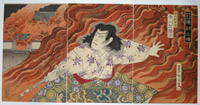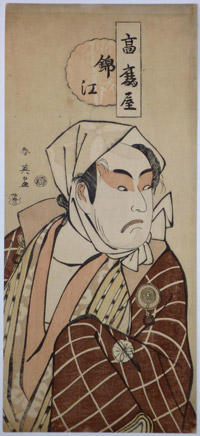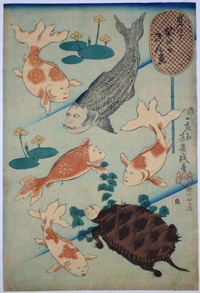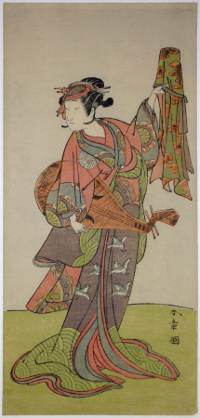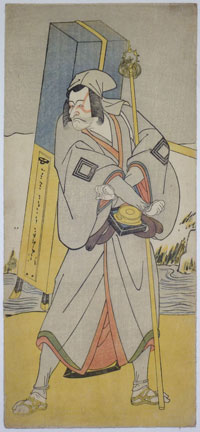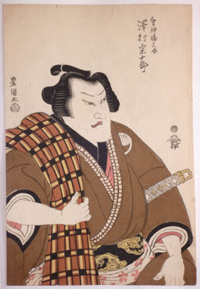/category/actors/page/6/
Toyohara KUNICHIKA (1835-1900)
Click here to view image full size.
The actor Ichikawa Sandanji I as Akiyama Kiimori holding a sword amidst a conflagration. Yakiuchi no ba from a set Meijiza Shinkyogen, “New Plays for the Meiji Theatre.” Although the play is unidentified the house in the background has been set on fire in an attempt to capture the hero Kiimori. Kunichika’s best print in this genre. Published by Akiyama Buemon, 1894.
Fine impression and colour. Light album backing, otherwise fine condition. Signed Toyohara Kunichika hitsu.
Status: Sold
Katsukawa SHUN’EI (1762-1819)
Click here to view image full size.
The actor Matsumoto Koshiro IV. One of a rare series of bust portraits, each with the haigo ( poetic ) name and a fanciful title. Here: Kinko and Koraiya. Koshiro was well known as a haiku poet. Published by Iseya Jisuke, c early 1790s. Originally purchased by me at Sothebys, 13/12/1993, lot 12.
Very good impression. Slight fading, otherwise very good condition. Full size. Signed Shunei ga.
Status: Sold
Utagawa YOSHIIKU (1833-1904)
Click here to view image full size.
A rare print with title in a fishing net: Mitate nitaka kingyo, “A Parody of Goldfish with Actor’s Expressions.” The public would, of course, have recognised these actors, and Kuniyoshi and several pupils had a penchant for them. Indeed, Yoshiiku went on to be a cartoonist for the Tokyo Eiri Shimbun [ newspaper ]. Published 1863.
Very good impression and colour. Minor soil, otherwise very good condition. Signed Ikkeisai Yoshiiku giga.
Status: Sold
Katsukawa SHUNSHO (1726-1792)
Click here to view image full size.
The actor Nakamura Nakazo I as Prince Koreakira, younger brother of Emperor Go-Toba, in the play Gohiiki Kanjincho performed at the Nakamura Theatre, 1/11/1773. This scene shows Nakazo as the evil prince about to be confronted by Kumai no Taro ( in this case Ichikawa Danjuro V ) in the Shibaraku scene. Ex collection H.R.W. Kuhne, sold Sothebys 11/6/1993, lot 62. Another impression from the Clarence Buckingham collection, ex Frank Lloyd Wright, is illustrated in the Actor’s Image, Clark & Ueda, 1994, no. 66, p. 196.
Very good impression, colour and condition. An exceptional hosoban with the motif on the white court robes blind printed: An extremely rare effect in the hosoban format. Signed Shunsho ga.
Status: Sold
Katsukawa SHUNSHO (1726-1792)
Click here to view image full size.
The actor Nakamura Tomijuro I in an unidentified female role holding a biwa (a lute-like musical instrument) underarm. Surprisingly not listed in The Life And Works Of Katsukawa Shunsho, Frederick William Gookin, which is the most comprehensive overview. Published c 1775/6.
Fine impression and colour. One small repaired wormhole, otherwise exceptional condition. Signed Shunsho ga.
Status: Sold
Utagawa KUNISADA (1786-1864)
Click here to view image full size.
A bust portrait of the onnagata actor Nakamura Matsue III as the courtesan Akoya. A part he played at the Nakamura theatre, 9/1814, in the play Dannoura kabuto gunki, Battle Tale of Dannoura.” The story tells of Akoya’s loyalty to her Heike lover Taira no Kagekiyo when on being captured she convinces Kagekiyo’s enemies of her ignorance of his hiding place aided by her exquisite music. From Kunisada’s finest set: Oatari kyoden no uchi, “Great Performances.” A set of seven prints of celebrated roles of the previous eight years selected from the Oatari kyoden, “Big Hits.” Sumptuously produced with mica grounds which had not been used for twenty years. Exceedingly rare, on a par with many Sharaku prints. Published by Fukusendo, c 1815. Another impression is in the Museo d’Arte Orientale “Edoardo Chiossone,” Genoa ( S1396 ) and a second is in the Ronald Cavaye collection.
Fine impression. Turning of colour towards bottom right, otherwise good colour. Mica good. Slight staining au verso which shows through mica, otherwise good condition. Full size. Signed Gototei Kunisada ga.
Status: Sold
Attributed toTorii KIYOTSUNE (Active c1757–1779)
Click here to view image full size.
A quarter-block, 5 x 6 in; 12.5 x 15 cms print showing the actors Segawa Kichiji III ( right ) in an onnagata role ( unread ) and Bando Matataro IV as Harada Rokuro in the play Kono hana yotsugi no hachinoki performed at the Ichimura-za in the 11th month of 1771.
Fine impression with perfect colour. Small binding holes, otherwise fine condition.
Status: Sold
Attributed to Torii KIYOTSUNE (Active c1757–1779)
Click here to view image full size.
A quarter-block, 5 x 6 in; 12.5 x 15 cms print showing the actors Nakamura Sukegoro II ( right ) as Yamana Sozen and Nakamura Juzo II as Fuwa Banzaemon in the play Fukikaete tsuki mo Yoshiwara performed at the Moita-za in the 11th month of 1771.
Fine impression with perfect colour. Small binding holes, otherwise fine condition.
Status: Sold
Attributed to Katsukawa SHUNSHO (1726–1792)
Click here to view image full size.
The actor Ichikawa Danjuro V possibly as Moriya no Daijin disguised as Rokuju-rokubu in the play Miya-bashira iwao no butai, performed at the Morita 7/1773. Ex collection Walter von Scheven, 1878 – 1950, and bought by him from Aoyama, Paris in 1929.
Fine impression, colour and condition. Unsigned.
Status: Sold
Utagawa TOYOKUNI I (1769–1825)
Click here to view image full size.
The centre sheet of a hosoban triptych possibly showing Danjuro VI as Ashikaga Takauji or Prince Takahiro. Ex collection Walter von Scheven, 1878 – 1950, and purchased by him at Altkunst, Berlin in 1929. A fine design.
Fine impression and colour. Very small repaired binding holes, otherwise fine condition. Unsigned.
Status: Sold
Ippitsusai BUNCHO ( Fl. c. 1765 – 92 )
Click here to view image full size.
A fine full length hosoban portrait of the actor Ichikawa Benzo I in the role of Kuretake in the play Tenjiku Tokubei kokyo no torigashi performed at the Nakamura-za in the 8th month of 1768. A very damaged example is illustrated in Exhibition of Ukiyo-e by Ippitsusai Buncho, Riccar Art Museum, 1978, no. 23.
Very good impression. Background turned, otherwise very good colour. Slight toning, otherwise very good condition. Signed Ippitsusai Buncho ga.
Status: Sold
Torii KIYONOBU II (1706-1763)
Click here to view image full size.
A fine urushi-e hosoban showing the actors Sawamura Sojuro I ( above ) and Yamamoto Kiyoshiro I wrestling amongst bales of rice. It is impossible to be certain of the performance as records are scant, but Sojuro is probably playing the role of Sano Genzaemon and Kiyoshiro is probably playing Sano Genta in the play Miyakozome kaoru hachinoki performed at the Nakamura-za in the 11th month of 1739. Kiyoshiro was from the Kamigata region and only arrived in Edo in this month. He left for Osaka the following year. Although he did visit Edo once before this date, he did not act with Sojuro at that time.
Very good impression. The hand-applied colours well retained. Small restorations to the sumi/brass, otherwise good condition. Signed Torii Kiyonobu hitsu.
Status: Sold
Utagawa TOYOKUNI I (1769-1825)
Click here to view image full size.
The actor Ichikawa Yaozo III as Umeomaru, the loyal retainer of Kan Shojo in the Kuruma biki, “Pulling the Carriage Apart,” scene from the play Sugawara denju tenarai kagami, “ Sugawara’s Secrets of Calligraphy” performed at the Miyako Theatre 7/1796. This is one of the most celebrated scenes in Kabuki, showing the stand-off between the brothers Umeomaru and Sakuramaru and Matsuomaru and Shihei. Of the utmost rarity. Toyokuni also designed prints of Matsuomaru and Shihei ( see this website ) and a triptych of the scene from the same play. One of ukiyoe’s great portraits. Umeomaru ( ume, “plum” ) is shown with the red sugi guma makeup of the impetuous hero, and plum blossom on his costume. Published by Yamaguchiya Tadasuke, 1796.
Fine impression. Mica-ground. Probably trimmed at top or bottom but I cannot, at the moment, locate another impression to compare. Some fading and other minor marks; small edge restoration. The role annotated top left in sumi ( as are other famous designs – possibly by the same collector ). As I cannot locate another impression and it’s unlikely there are more than a few, at best, impressions extant, a certain compromise on condition is necessary. Signed Toyokuni ga.
Status: Sold
Utagawa TOYOKUNI I (1769–1825)
Click here to view image full size.
The actor Kataoka Nizaemon VII as the evil Minister of the Left Fujiwara Shihei in the Kuruma biki, “Pulling the Carriage Apart,” scene from the play Sugawara denju tenarai kagami, “ Sugawara’s Secrets of Calligraphy” performed at the Miyako Theatre 7/1796. This is one of the most celebrated scenes in Kabuki, showing the stand-off between the brothers Umeomaru and Sakuramaru and Matsuomaru and Shihei. Of the utmost rarity: Another impression illustrated in Ukiyoe Taikei, vol. 9, no. 19 and also used for the cover of the book and slip-case. Toyokuni also designed mica-ground prints of Matsuomaru and Umeomaru ( see this website ) and a triptych of the scene from the same play – all excessively rare. One of ukiyoe’s great portraits. Published by Yamaguchiya Tadasuke, 1796.
Very good impression. The eyes with brass powder applied. Trimmed heavily top and bottom and very slightly at side. Some fading, soil and other minor marks. The role annotated in sumi top left. Other famous designs are known with these inscriptions ( by the same hand ? ). However, given the rarity and that, at best, there can only be a few impressions extant, a certain compromise is necessary. Signed Toyokuni ga.
Status: Sold
Torii KIYOMITSU (1735-1780)
Click here to view image full size.
A hosoban benizuri-e print in beni, yellow and blue showing the actor Segawa Kikunojo II ( bottom left ) in the role of musume Kagekiyo and Ichimura Uzaemon IX ( top right ) as Osu … possibly Osutoko. “Musume” means “daughter”, while Kagekiyo was the famous general of the Heike clan. However, if Kikunojo were playing Kagekiyo’s daughter then it would be written Kagekiyo musume. ( His daughter was named Hitomaru and she does indeed feature in many plays about him. ) But in this case, it perhaps refers to a female version of Kagekiyo although no information on this is to hand. However, if Kikunojo is playing Kagekiyo’s daughter after all, and it’s just written the other way round for some reason, then it would identify the performance and date nicely: the play would be Soga yawaragi Soga performed at the Ichimura-za in the 1st month of 1767. Published by Nishimura, Eijudo han. Extremely rare. ( Many thanks to Paul Griffith for the elucidation above. )
Fine impression and colour. Slight vertical fold and small expertly restored wormhole near bottom edge. Signed Torii Kiyomitsu ga.
Status: Sold
Tsukioka YOSHITOSHI (1839-1892)
Click here to view image full size.
Onoe Kikugoro V as the Hag of Adachi Moor from the Kabuki play Adachigahara (aka Hitotsuya, “The Lonely House”) performed at the Ichimuraza Theatre 4/5/1890. One of a series of three triptychs showing half-length portraits of actors based on the Snow, Moon, Flowers theme. This being Flowers represented by the yugao,”gourds” – moon-flowers. Considered to be amongst Yoshitoshi’s best designs. The Hag was a cannibalistic old woman who preyed on travellers – especially pregnant women. Published by Akiyama Buemon, 1890.
Very fine impression. Mint condition. The best example I have seen. Signed Okokkeidoju Yoshitoshi ga
Status: Sold
Toyohara KUNICHIKA (1835-1900)
Click here to view image full size.
The actor Ichikawa Danjuro IX in shibaraku role. A fine triptych, Kabuki juhachiban no uchi/shibaraku, “The Eighteen Famous Kabuki Plays: Shibaraku.” Published by Fukuda Kumajiro, 8/1895.
Fine impression, colour and condition. Signed Oju Kunichika hitsu.
Status: Sold
Toyohara KUNICHIKA (1835-1900)

Click here to view image full size.
A triptych showing Danjuro IX as Yanone (arrowhead) Goro (Soga Goro). Published 1882 by Kamiyama Seishichi. Poem by Sansho the 9th (Danjuro).
Very good impression and colour. Slight trimming, otherwise very good condition. Signed Oju (“by special request”) Toyohara Kunichika hitsu.
Status: Sold
Rekisentei EIRI (active 1790-1810)
Click here to view image full size.
An uki-e “perspective view” of a Kabuki theatre Edo Sakai-cho Shibai no zu showing Danjuro VII as Gongoro in the play Shibaraku “Wait a Moment.” He is shown on the hanamichi, the “flower path” walkway. His impressive costume consists of foot-high clogs, gigantic sleeves stretched out on bamboo struts and a seven or eight foot sword. The mimasu, “three rice measure” personal crest is clearly visible. Published c early 1800s by Izumiya Ichibei.
Very good impression and colour. Slight soil down right edge. Signed Rekisentei Eiri ga.
Status: Sold
Utagawa TOYOKUNI I (1769-1825)
Click here to view image full size.
A fine late single bust of Matsumoto Koshiro V as Tsurugisawa Danjo Saemon in the “Beneath the Floor” scene of the play Shikisemono Soga no Datezome performed at the Morita-za in the 1st month of 1813. Here the arch villain Danjo, master of the black arts, has just risen on a stage lift in a cloud of smoke, having transformed back into human form from that of a giant sewer rat. His hands are still held in the position of a magic spell as he confronts the loyal warrior Otokonosuke who was standing guard in the cellar beneath his lord’s quarters. This print is one of a pair (not a diptych), the other showing Ichikawa Danjuro VII as Otokonosuke. (See Boston MFA for a much trimmed impression of this design acc. No 11.25348.)
Fine impression. Slight turning of the purple towards the edge. Some uneven trimming also into signature, otherwise good condition. Signed Toyokuni ga.
Status: Sold
Utagawa TOYOKUNI I (1769-1825)
Click here to view image full size.
A double bust portrait showing Onoe Matsusuke I (above) as the evil lady-in-waiting Iwafuji and Iwai Kumesaburo I as Ohatsu, maidservant to lady-in-waiting Onoe, in the “Inner Garden” scene of the play Kagamiyama Kokyo no Nishiki-e performed at the Ichimura-za in the 3rd month of 1803. In this scene the loyal maid Ohatsu finally avenges the shame brought upon her lady Onoe and her subsequent death, by fighting and killing the evil Iwafuji. The latter is one of Kabuki’s great female villains and the role is often given to an actor of male roles to emphasise her unattractive nature. Another impression was in the Succo collection. Illustrated in Toyokuni, Friedrich Succo, R.Piper & Co, 1913, no 523, p. 80. Published by Nishimuraya Yohachi, 1803.
Fine impression. Some oxidation, otherwise very good colour. Light album backing and very small binding holes. Very good condition. Signed Toyokuni ga.
Status: Sold
Torii KIYOMITSU (1735-1785)
Click here to view image full size.
The actor Nakayama Bunshichi. . Kiyomitsu was the final flowering of the Torii School and a pioneer of the polychrome print. Harunobu went on to fully exploit the technique using a variety of unusual pigments and overprinting to produce a yet larger palette unsurpassed in the following years. This print has all the hallmarks of a “proof” impression with best quality hosho and extra paper left and top. Printed in beni, yellow ochre, orange ( yellow over beni ), puce, light blue-grey and a grey ground. Published c 1768.
Perfect preservation as the day it was printed. Superb impression, colour and condition. Immaculate keying of the blocks. Signed Torii Kiyomitsu ga.
Status: Sold
Katsukawa SHUNSHO (1726-1792)
Click here to view image full size.
The actors Ichikawa Yaozo II as the samurai Gunsuke, a retainer of the Yoshida family, and Nakamura Nakazo I as Hitokai Sota in a play performed at the Nakamura Theatre, spring 1770. Not listed by F.W. Gookin. Annotated top right by a fan of the theatre. A superb hosoban from Shunsho’s prime.
Very fine impression with the body outlines gauffraged. Fine colour and condition. Signed Shunsho ga with tsubo seal.
Status: Sold
Utagawa TOYOKUNI I (1769-1825)
Click here to view image full size.
The well-muscled bodyguard Narukami Kajinosuke played by Sawamura Sojiro IV in the play Sugata no hana azuma no date-zome performed at the Ichimura-za Theatre, 3/1812. Published by Suzuki Ihei,1812. There is a companion design to this print showing Bando Mitsugoro as Kaminari Tsurunosuke.
Fine impression and colour. Very slightly trimmed at bottom, otherwise good condition. Minimal soil. Signed Toyokuni ga.
Status: Sold
Utagawa KUNIYOSHI ( 1797-1861 )
Click here to view image full size.
One print from a set of four with title Miburi juni omoi gatsu, “Gestures for the Twelve Months.” Each “gesture” or “caricature” is being performed by a Kabuki actor: So here the 6th month is Nakamura Tsuruzo imitating the serpent of Mt Fuji ( upper right ); 7th month is Otani Tomoemon IV as the gargoyle Onigawara ( lower left ); 8th month is Ichikawa Kuzo II as the turtle-like water sprite Enko ( lower right ); 9th month is Onoe Kikujiro II as the chrysanthemum butterfly. Published c 1847-48 by Ebisuya Shoshichi. Rare.
Fine impression, colour and condition. Signed Ichiyusai Kuniyoshi giga, “Drawn for fun.”
Status: Sold
Tsukioka YOSHITOSHI ( 1839-1892 )
Click here to view image full size.
A rare diptych showing the actor Ichikawa Danjuro IX as Saijo Takamori ( = Saigo Takamori ) in the play Okige no kumo harau asagochi by the playwright Kawatake Shinshichi II performed at the Shintomi-za Theatre from the 23rd of the second month, 1878. Saigo Takamori was leader of the rebellion against the Meiji government in 1877. Published by Tsuda Genshichi and dated the 15th of the second month, so it was issued as pre-publicity.
Very fine impression of the first edition with variegated cartouche; colour wiped across the background, and the Danjuro 3-chocolate coloured Mimasu bands around the border. The background is also fnely blind-printed. I have located several other impressions ( one in the Bunka digital library ) that are later printings, lacking the embellishments listed above. Fine colour and condition. Signed Oju Taiso Yoshitoshi ga.
Status: Sold
